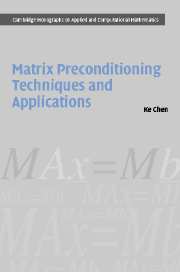Book contents
- Frontmatter
- Contents
- Preface
- Nomenclature
- 1 Introduction
- 2 Direct methods
- 3 Iterative methods
- 4 Matrix splitting preconditioners [T1]: direct approximation of An×n
- 5 Approximate inverse preconditioners [T2]: direct approximation of An×n−1
- 6 Multilevel methods and preconditioners [T3]: coarse grid approximation
- 7 Multilevel recursive Schur complements preconditioners [T4]
- 8 Sparse wavelet preconditioners [T5]: approximation of Ãn×n and Ãn×n−1
- 9 Wavelet Schur preconditioners [T6]
- 10 Implicit wavelet preconditioners [T7]
- 11 Application I: acoustic scattering modelling
- 12 Application II: coupled matrix problems
- 13 Application III: image restoration and inverse problems
- 14 Application IV: voltage stability in electrical power systems
- 15 Parallel computing by examples
- Appendix A a brief guide to linear algebra
- Appendix B the Harwell–Boeing (HB) data format
- Appendix C a brief guide to MATLAB®
- Appendix D list of supplied M-files and programs
- Appendix E list of selected scientific resources on Internet
- References
- Author Index
- Subject Index
- Plate section
13 - Application III: image restoration and inverse problems
Published online by Cambridge University Press: 06 January 2010
- Frontmatter
- Contents
- Preface
- Nomenclature
- 1 Introduction
- 2 Direct methods
- 3 Iterative methods
- 4 Matrix splitting preconditioners [T1]: direct approximation of An×n
- 5 Approximate inverse preconditioners [T2]: direct approximation of An×n−1
- 6 Multilevel methods and preconditioners [T3]: coarse grid approximation
- 7 Multilevel recursive Schur complements preconditioners [T4]
- 8 Sparse wavelet preconditioners [T5]: approximation of Ãn×n and Ãn×n−1
- 9 Wavelet Schur preconditioners [T6]
- 10 Implicit wavelet preconditioners [T7]
- 11 Application I: acoustic scattering modelling
- 12 Application II: coupled matrix problems
- 13 Application III: image restoration and inverse problems
- 14 Application IV: voltage stability in electrical power systems
- 15 Parallel computing by examples
- Appendix A a brief guide to linear algebra
- Appendix B the Harwell–Boeing (HB) data format
- Appendix C a brief guide to MATLAB®
- Appendix D list of supplied M-files and programs
- Appendix E list of selected scientific resources on Internet
- References
- Author Index
- Subject Index
- Plate section
Summary
An inverse problem assumes a direct problem that is a well-posed problem of mathematical physics. In other words, if we know completely a “physical device,” we have a classical mathematical description of this device including uniqueness, stability and existence of a solution of the corresponding mathematical problem.
Victor Isakov. Inverse Problems for Partial Differential Equations. Springer-Verlag (1998)Image restoration is historically one of the oldest concerns in image processing and is still a necessary preprocessing step for many applications.
Gilles Aubert and Pierre Kornprobst. Mathematical Problems in Image Processing. Springer-Verlag (2002)However, for the time being it is worthwhile recalling the remark of Lanczos: “A lack of information cannot be remedied by any mathematical trickery.” Hence in order to determine what we mean by a solution it will be necessary to introduce “nonstandard” information that reflects the physical situation we are trying to model.
David Colton and Rainer Kress. Integral Equation Methods in Scattering Theory. Wiley (1983)The research of inverse problems has become increasingly popular for two reasons:
(i) there is an urgent need to understand these problems and find adequate solution methods; and
(ii) the underlying mathematics is intriguingly nonlinear and is naturally posed as a challenge to mathematicians and engineers alike.
It is customary for an introduction to inverse problems of boundary value problems to discuss the somewhat unhelpful terms of ‘ill-posed problems’ or ‘improperly-posed problems’.
- Type
- Chapter
- Information
- Matrix Preconditioning Techniques and Applications , pp. 415 - 448Publisher: Cambridge University PressPrint publication year: 2005



